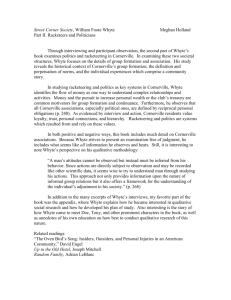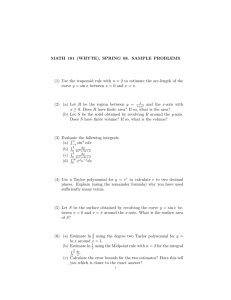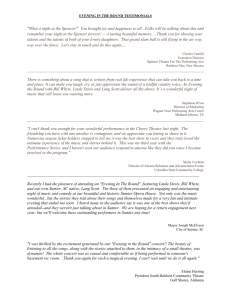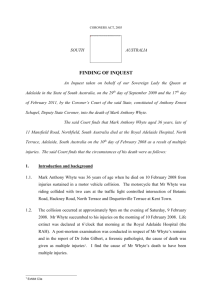Critical Review of Ethnographic Reports
advertisement
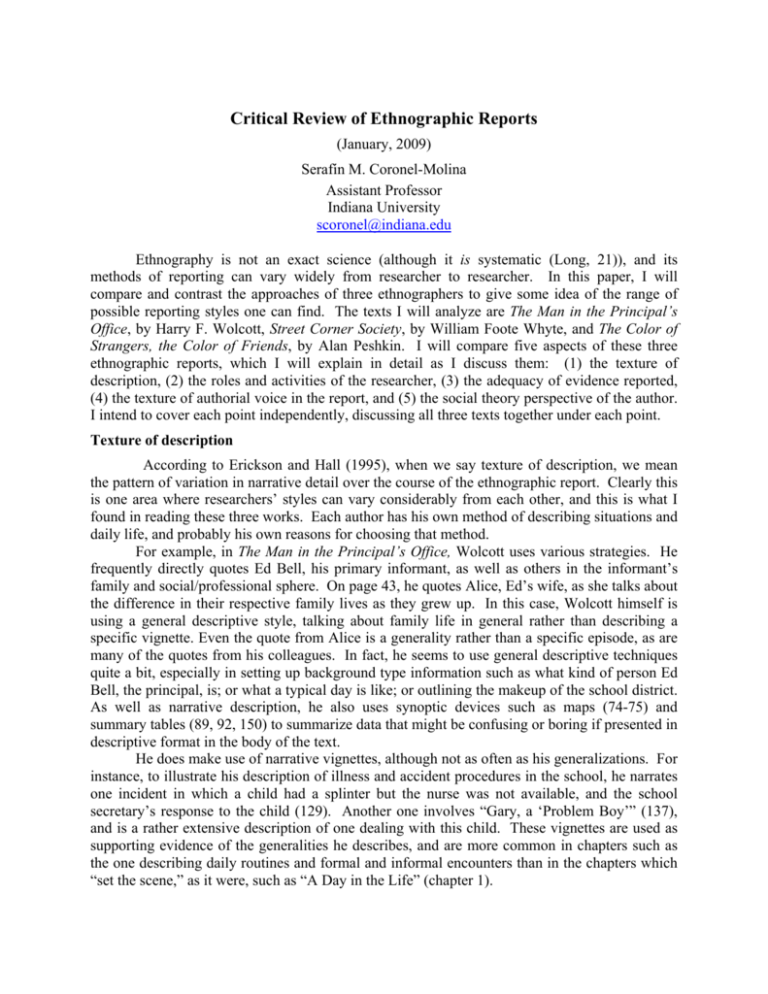
Critical Review of Ethnographic Reports (January, 2009) Serafín M. Coronel-Molina Assistant Professor Indiana University scoronel@indiana.edu Ethnography is not an exact science (although it is systematic (Long, 21)), and its methods of reporting can vary widely from researcher to researcher. In this paper, I will compare and contrast the approaches of three ethnographers to give some idea of the range of possible reporting styles one can find. The texts I will analyze are The Man in the Principal’s Office, by Harry F. Wolcott, Street Corner Society, by William Foote Whyte, and The Color of Strangers, the Color of Friends, by Alan Peshkin. I will compare five aspects of these three ethnographic reports, which I will explain in detail as I discuss them: (1) the texture of description, (2) the roles and activities of the researcher, (3) the adequacy of evidence reported, (4) the texture of authorial voice in the report, and (5) the social theory perspective of the author. I intend to cover each point independently, discussing all three texts together under each point. Texture of description According to Erickson and Hall (1995), when we say texture of description, we mean the pattern of variation in narrative detail over the course of the ethnographic report. Clearly this is one area where researchers’ styles can vary considerably from each other, and this is what I found in reading these three works. Each author has his own method of describing situations and daily life, and probably his own reasons for choosing that method. For example, in The Man in the Principal’s Office, Wolcott uses various strategies. He frequently directly quotes Ed Bell, his primary informant, as well as others in the informant’s family and social/professional sphere. On page 43, he quotes Alice, Ed’s wife, as she talks about the difference in their respective family lives as they grew up. In this case, Wolcott himself is using a general descriptive style, talking about family life in general rather than describing a specific vignette. Even the quote from Alice is a generality rather than a specific episode, as are many of the quotes from his colleagues. In fact, he seems to use general descriptive techniques quite a bit, especially in setting up background type information such as what kind of person Ed Bell, the principal, is; or what a typical day is like; or outlining the makeup of the school district. As well as narrative description, he also uses synoptic devices such as maps (74-75) and summary tables (89, 92, 150) to summarize data that might be confusing or boring if presented in descriptive format in the body of the text. He does make use of narrative vignettes, although not as often as his generalizations. For instance, to illustrate his description of illness and accident procedures in the school, he narrates one incident in which a child had a splinter but the nurse was not available, and the school secretary’s response to the child (129). Another one involves “Gary, a ‘Problem Boy’” (137), and is a rather extensive description of one dealing with this child. These vignettes are used as supporting evidence of the generalities he describes, and are more common in chapters such as the one describing daily routines and formal and informal encounters than in the chapters which “set the scene,” as it were, such as “A Day in the Life” (chapter 1). 2 On the other hand, Whyte relies very heavily on analytic vignettes and particular narration. His information comes primarily from an informant called Doc, as well as conversations with the various members of the gangs he observes. He quotes Doc and others extensively, often for a whole page or more at a time. In fact, it seems like a vast majority of his narrative is page after page of direct citations of his informants. Again, like Wolcott, he uses general descriptions to set the scene, and occasionally synoptic devices such as organizational charts of the various gangs. For example, right away on his opening page, he quotes Doc talking about what his childhood was like in general, and how he got involved with his gang. And in fact, inside that one quote, Doc uses both general and particular description, when he talks about his first fight at the age of 12 (3-4). The interesting thing about Whyte’s style is that both general descriptions and narrative vignettes are almost invariably told by the participants themselves, rather than by Whyte as a narrator. The difference between Whyte and Wolcott is that where Wolcott relies more heavily on general description and synoptic devices, with only the occasional particular vignette, Whyte depends on the specific, and especially on the voices of the participants themselves describing these specifics. Whyte tells his story through particulars, and returns to generalities to present his conclusion. Even his organizational charts are specifically detailed to one gang at one point in time; in contrast, Wolcott’s maps and tables summarize general background information. In The Color of Strangers, we have yet another style of description. Again, like Wolcott, he uses more general description than particular, although of course, it is included occasionally for examples and supporting evidence. However, he does not use any of the synoptic devices used by the other two authors: there are no charts, tables or maps to be found in the book. The only such devices are an illustration of the layout of bumper stickers on the back of a van (181), and a statistical table identifying percentages of ethnicities reflected in the school population (101). He quotes informants very frequently, but only bits and pieces, not like Whyte for pages at a time. His story becomes made clear through the voices of these informants, as in Whyte, but the voices are scattered, more like in Wolcott’s narrative. They are not joined in a coherent conversation or narration as Whyte presents. Also, and this is contrary to both other authors, many times he does not identify his sources, but merely says “a prominent politician,” or “a black woman,” etc. I would say it runs about 50/50 between specifically identifying the speaker and not. From the above discussion it becomes obvious that there are a variety of descriptive styles available for ethnographic works. I have only looked at three authors, but those three have each approached their task differently, although with some overlaps and similarities. Even so, I think it would be safe to say that there are most likely (nearly) as many descriptive styles, each with its own purpose and utility according to context, as there are ethnographers publishing their work. Roles/activities of researchers Erickson and Hall (1995) clarify that the roles and activities of researchers concern the access of the ethnographer to the information potentially available in the setting. In two of the three cases, the role filled by the researcher was that of participant observer, as explicitly stated in their introductions. In the case of Wolcott’s study, he describes himself in his introduction as a “shadow” to the principal, which I took to mean non-participant. However, Jorgensen defines the participant role as “provid[ing] access to the world of everyday life from the standpoint of a member or insider.” (20) According to this definition, one might argue that Wolcott’s was a 3 modified type of participant observation, due to the nature of his data collection technique. He followed Ed Bell around everywhere, attending meetings, witnessing interactions between the principal and teachers, between him and students, even listening in on Ed’s side of professional and personal telephone calls. While he was not directly participating in the daily action of a principal’s job, he was very nearly inside the principal’s skin on a daily basis, and had a very intimate view of what it was to be this particular principal. In all three cases, as above in descriptive styles, each approached his participation in slightly different ways. Peshkin, for example, describes his role as participant observer, but adds that his year of observation was actually more or less roughly divided between participant and non-participant activities (xii). Whyte clearly states in his introduction that he was a participant in the activities he was observing; and I have already discussed Wolcott’s approach above. Obviously, participant observation has strong advantages, since you can get a picture of daily life that combing through archives or interviewing people will not give you. As Whyte says in his introduction, [T]he newspaper presents a very specialized view. If a racketeer commits murder, that is news. If he proceeds quietly with the daily routines of his business, that is not news.... The newspaper concentrates upon the crisis – the spectacular event.... [The “big shot”] is removed from the society in which he functions and is judged by standards different from those of his own group. (xvi) However, those non-participant techniques also have their place, as they may be able to provide a degree of objectivity, the clarity of an outside perspective perhaps not available to the insider. In other words, the subjective viewpoint of the insider or participant observer is not necessarily the ideal means to uncover all the social patterns one might want to uncover. Peshkin acknowledges this in dividing his time between participating in the daily life and activities of the school and combing the archives and interviewing people both inside and outside the community he is studying. Wolcott also interviews various insiders, such as the principal’s wife, teachers, and other administrators, to round out his perspective of life inside Ed Bell’s skin. No study is ever perfect, and there are always things that could have been done, or done differently, to improve a work. The same is true of these three works, although I admit that I find them all compelling and apparently complete. It took searching in obscure corners to find areas of “incompleteness.” Except perhaps in the case of Peshkin, who provides us with evidence of what he perceives as a possible weakness, in his appendix. He discusses his struggle with his own subjectivity, and how it might have colored his handling of some of the data that he gathered: “This particular subjective I softens one’s judgment.... Its by-product is affection, which tends to reduce the distance between self and subjects that scholars presume is necessary to learn and write about a person, place, or institution.” (293) As he points out, subjectivity is impossible to avoid, so as he says, he tries to keep himself aware of it, so he can try to analyze (and therefore hopefully exorcise) how it is affecting his observations and his interpretations. For the same reason discussed by Peshkin, subjectivity is also potentially a problem in Whyte’s work. Whyte clearly develops a genuine affection for these people with whom he works, which could easily influence how he views them and how he writes about them. His style of writing overall seems very non-judgmental and even objective, so perhaps he too is aware enough of his own subjectivity to be able to control it. But because we don’t have access to the original scenarios as he lived them, we can’t witness what he witnessed, we have no way of verifying that. Subjectivity is perhaps the hardest of all influences to overcome; unlike the filter on a camera, which can be removed to provide an “accurate” picture, one’s personal/cultural 4 filter is part of oneself, and cannot be removed at will. It will always leak through at least a little in what and how you view, and report on, the world. However, subjectivity is not the only aspect of any given work open to critique. For example, Erickson discusses the importance and the difficulty of obtaining evidence of implicit cultural knowledge, beliefs and perspectives so ingrained in a way of life that the natives are not themselves consciously aware of them, “and thus [can] not be readily articulated by informants.” (88) In a case such as Wolcott’s, where he is detailing only one specific man’s professional life, perhaps this is not so critical, but implicit cultural knowledge would indeed be very important for both Whyte’s and Peshkin’s projects. Whyte seems to cover this area very well; he has clearly gotten inside his subjects’ heads to the point of understanding even their most unconscious motivations. However, Peshkin does not seem to have done this as effectively. First of all, he is dealing with a multiplicity of cultures: blacks, Filipinos, Mexican-Americans. This mix of cultures also implies a mix of languages, which will certainly affect his informants’ world views and also possibly limit their expressiveness. Also, since he is following such a large population, it can be expected that gender will also play a role in certain interactions. Due simply to the fact of being male, white, and upper-middle class, he may not have access ever to some sources and perspectives, simply because his position as “other” will make him permanently distrusted. However, as for the possible language barriers, perhaps he could have enlisted the aid of interviewers (for the non-participant portion of his work) from those backgrounds, who could have communicated with the interviewees in their own languages, thus assuring at least the possibility of more detailed and revealing answers. Adequacy of evidence As Erickson and Hall (1995) outline, supporting evidence for ethnographic fieldwork can and should come in a variety of forms: observation and fieldnotes, interviews, review of site documents, videotapes, etc. Of course, evidence of these sources should also be apparent in the ethnographic report itself, as in analytic narrative vignettes, quotes from fieldnotes or interviews, or synoptic data reports such as the maps, tables, and charts used in Wolcott and Whyte. (Erickson, 151) As Pittman and Maxwell indicate, triangulation is an important means of structural corroboration: ...the use of multiple sources and types of data to support or contradict an interpretation. Acknowledging that qualitative research allows more scope for researchers to see what they choose and, thus, greater chance for the intentional neglect of evidence contrary to one’s values or interests, Eisner argues that, “it is especially important not only to use multiple types of data, but also to consider disconfirming evidence and contradictory interpretations or appraisals when one presents one’s own conclusions [italics in original] (Eisner, 1991: 111). (748) In general, these three authors used a wide range of types of supporting materials, which coincides with part of the above definition. However, as I discuss in more detail later, I did not see much evidence of contradictory materials or data in any of the works. Some of these forms of evidence have been discussed above in the section on texture of description. Following are more examples from all three works. I would like to preface this list of examples by saying that I felt that in two of the cases, an appropriately wide variety of sources was used. In Whyte’s work, however, the primary evidence is his detailed fieldnotes and transcripts of interviews or conversations with some of the gang members. Since his work was 5 done in the mid 1930’s, perhaps some of these other forms of information would not have existed or not been practical. At any rate, he does not show as explicitly as the other two authors a broad range of informational sources. For instance, his only type of synoptic data are his organizational charts of the different gangs; he provides no kind of statistical or quantitative data. However, his account is so detailed and so apparently complete, one does not notice the lack. And his detailed accounts easily support his main thesis that life on the streets of “Cornerville” was not as amorphous as the dominant society would like to believe, but was in fact highly organized and hierarchical. Wolcott also provides a very complete picture of his subject, Ed Bell the principal. As indicated in his preface, his main purpose in pursuing the study was to inductively “describe and analyze the elementary school principalship from a cultural perspective.” (xi) I say inductively, because he uses the case of one principal to try to extrapolate to a general conclusion of the situation of all, or at least most, principals. He justifies this approach by saying, “The test of ethnography is whether it enables one to anticipate and interpret what goes on in a society or social group as appropriately as one of its members.” (xi) He uses many of the techniques and sources of information outlined by Erickson. Besides his extensive field notes, taken while shadowing the principal for two years, he also has access to maps of the school district, taped telephone conversations, copies of brochures and other memos and such sent out to the community regarding the school/district, and other such school and district files as Ed and the district office allow him (which appears to be considerable). On pages 73-78 and again on 212-16, he reproduces the text of conversations between Ed and a new teacher, and Ed and another administrator, respectively. Also, on pages 106-112, he provides the transcript of part of a faculty meeting. He utilizes various tables to summarize school district activity, teacher data, and statistical data regarding various functions of the principal. He combines quantitative data with qualitative, which helps to provide more detail in a more concise manner. Peshkin also uses a variety of sources to support his assertion that ethnicity does not play a significant role in formation of friendships and liaisons in his target community. As he discusses in his introduction, he uses participant observation, newspaper accounts, demo-graphic data (which he represents in his one statistical table, on page 101), and non-participant interviews, of everyone from students and their parents to the school board. These sources are reflected in his work in direct citations from the interviews, and the occasional quote from newspaper articles and narrative vignette. He is very careful to identify the gender of the speaker in any given case, although he does not then turn around and draw any specific conclusion based on divisions along gender lines. Because of this, I found his care in this regard a little puzzling. And while he includes the appropriate elements listed by Erickson (151) that belong in a “good” ethnographic report, still somehow his account did not seem as rich to me as the other two. This is apparently my own subjectivity coming into play in this analysis. Texture of authorial voice Erickson and Hall (1995) indicate that texture of authorial voice has to do with the diversity and frequency of different voices which appear in the text, whether they are narrators or commentators. In this regard, all three works reflect a multiplicity of speakers, again using different strategies to link the voices into a coherent whole. As a starting point, all three researchers generally narrate specific histories in the past tense, but generalize about the situation of their fieldwork or present the analysis of their data in the present tense. For example, Peshkin talks of a specific student’s history: “Bill Garcia was a 6 high school student in 1968 and thus lacked the perspective of a Ralph Benson or Frank Cary.” But then a few sentences later, in analyzing Garcia’s actions and motivations, he says, “Garcia cannot find mitigating circumstances that condone violence; he pretends to no knowledge of history that offers insight on the status of blacks in Riverview or anywhere else.” (both, 82; emphases mine). Both of the other authors use the same technique. Since all did some type of participant observation, their narrative styles reflect that: they are all patently visible narrators, who include themselves in the actions and events they narrate. As discussed above in the section on roles and activities of the researcher, they all use a subjective voice in narrating, while at the same time trying to maintain a certain degree of objectivity in analyzing and presenting conclusions. In other words, the narratives are written in the first person, not only in narrating specific events in which the authors were personally involved, but also to varying degrees in their analyses and conclusions. Another example of this comes from Peshkin: “Though I have been writing about civility and mingling as contributors to ethnic peace, I cannot specify which, strictly speaking, came first.” (255) Whyte also does this occasionally, although not with the frequency that Peshkin does. For instance: “School years modified the original pattern somewhat, but I know of no corner gangs which arose through classroom or school-playground association.” (255) Wolcott uses this strategy the least of the three authors; in general, his analyses are objective and third-person centered. His own voice comes more into play in narrating events. So one could say he plays with subjectivity and objectivity: he includes himself in events, but excludes himself from discussion and analysis. He plays with exclusion in another sense also. In narrating his history, he includes various voices, as mentioned briefly in a previous section: Alice, who is the principal’s wife, Ed Bell himself, other administrators, teachers, and even students. He includes them through partial quotes from interviews, through extensive transcripts of meetings, through dialogues and telephone conversations, even through interoffice memos and commentaries from their personnel records. But, while their voices are included in the narrative, included in a sense in the authorship of the work, they are excluded from a real position of authority in the overall scheme of the text. Their voices provide supporting material, the evidence to back up the assertions that Wolcott makes. But they do not narrate the story per se, and they certainly do not assert; they are not the story-tellers. One could say they are little more than incidental characters – even Ed Bell himself is only allowed a voice to support Harry Wolcott as the narrator. Peshkin also uses multiple voices in his account, and basically in the same way that Wolcott does. He also includes excerpts from interviews with teachers, students, family members of students; and he reproduces the language the way it is spoken in Riverview, in an effort to maintain the authenticity of those voices. However, ultimately, these voices, too, are no more than supporting characters for his narration, his viewpoint, and his analysis. In fact, he is the only narrator, despite the multiplicity of voices heard. And in fact, he uses the first person so extensively in both narration and analysis that the other voices end up seeming even more backgrounded than the voices in Wolcott’s text. He uses much shorter excerpts than does Wolcott, never more than a paragraph or so, compared with pages and pages of transcriptions in Wolcott. This cutting short of the supporting voices seems to me to allow them even less authority, to relegate them even more to supporting, background roles than they might otherwise have had. Of the three authors, he seems to provide the most additional commentary on his own judgments and conclusions within the body of the text itself. He is very concerned, as discussed earlier, with his own subjectivity, and how it might influence his interpretations of what he sees 7 and hears. Despite this, however, as far as I can recall, he doesn’t seem to question his own conclusions too closely. His comments center on how his subjectivity may have influence him, but he does not then turn around to offer other possible interpretations. In fact, in his concluding chapter, he states, As a complex place, Riverview and Riverview High also contain stories I have chosen not to tell, as well as many others that I’m not even aware are there for the telling. I choose to tell the story of a school and community that transcended a decade and more of ethnic strife to become a place of abiding mingling. (258; emphases mine) Whyte provides a completely different picture from these other two authors. His text also weaves a rich texture of voices, but in contrast to Wolcott and Peshkin, those other voices are authors and authorities within the text. They narrate the stories included in the text, in their own voices. For example, Doc speaks for much of the first chapter, which details the formation of the slum area gang. In the second chapter, Chick tells his story on the formation of his more upperclass gang, from a group that had access to more social and economic advantages than Doc’s group. Thus, much of the work is in first person, but not just one person’s first person. Whyte quotes the people he talks about for pages at a time, letting them narrate their own actions. It is only in his analyses that he switches to the third person, and as mentioned above, excludes even his own voice from these in favor of a strong attempt at objectivity. It is interesting to note, however, that those who contribute most to the actual narration, as opposed to providing quotes used as supporting material, are those who tend to have relatively high stature in their respective social groups (Doc, Angelo, Chick). Whyte does indeed use shorter quotes from a variety of people, from all levels of influence within the gangs, and as stated, these generally serve a supportive rather than a narrative function. Another detail that Whyte includes that is missing from the other two works is additional commentary from one of his narrators. Angelo, one of Doc’s “boys”, offers his interpretation of the events that Whyte narrates in an appendix to the text, and seems to be in complete agreement with Whyte’s accounting of things and his conclusions and analyses. He also talks about the influence that Whyte’s project, and even Whyte himself, had on the ultimate direction his life took. In general, his is a very positive voice with which to conclude the text. In sections apart from the actual texts, Wolcott and Whyte both comment on the role their personal subjectivities and idiosyncracies may have played in interpretation of their data; Wolcott addresses it in his prologue, and Whyte in his first appendix. They talk about what their backgrounds are, how those might have affected what and how they saw; but again, as with Peshkin, this self-awareness does not lead them to propose alternative readings of their data. And in fact, in the body of their texts, they made no mention of their questions about their own subjective perspectives, but presented conclusions and analyses as more or less facts to be accepted at face value, with no interpretation per se needed. 8 Social theory perspective In this last section, I will address the assumptions the authors seem to make about the nature of society and culture; that is, where along the social theory continuum they tend to place themselves. In class, we have discussed in some detail structural-functionalist theory and conflict theory, and so I have focused my search in those directions. First, I would like to begin with a definition of these two theoretical viewpoints, to establish a base from which to argue my opinions. Dobbert and Kurth-Schai talk about contemporary theories of order as being compatible with a biological, evolutionary perspective that seeks to explain things in terms of patterns of interactions or interrelationships. These patterns, they say, imply structured systems, including social systems, and they quote Nadel’s idea of social structure: ... people belong to a society in virtue of rules under which they stand and which impose on them regular, determinate ways of acting towards and in regard to one another.... Of the ways of acting so understood it is true to say that they are finite and always less numerous than the possible combinations of people: which means that the same ways of acting are repetitive in the population. (Nadel, 1957: 7). They continue on to point out that completely predictable systems are rare, and so ultimately they propose a blending of theoretical approaches. While they find much to recommend it in the structural-functionalist approach, they feel that other approaches also have some validity: “With poststructuralists, feminists, and critical theorists, we share assumptions about the contextual, evolutionary, and political nature of knowledge.” (150) I note this because it is in line with something I noticed; namely, that it was not possible to place at least one of the works completely within either a structural-functionalist view, or a conflict model as described by LeCompte and Preissle. Conflict theory, they say, opposes functional approaches not so much because of the analytical constructs used as because they doubt the accuracy or utility of the interpretations. These authors define functionalism as exploring the role of students within the status quo, within the “larger scheme of things... These studies did not question either the form and content of schooling or its function in society...”. (848-49) Conflict theory, on the other hand, was prepared to question the status quo, or perhaps more accurately, to study others’ questioning of it. “The primary contribution of conflict approaches was to introduce the concepts of asymmetries of power... They questioned the ‘naturalness’ or legitimacy and inevitability of the patterns of inequality and inequity to which educational activities contributed.” (849) I put so much emphasis on these definitions because they seem to me to summarize very well the approaches I saw in these three ethnographic works. Two of the three (Whyte and Peshkin) tell stories inherently based in change, in strife and conflict, which would make it all too easy to assume that they were necessarily speaking from a base in conflict theory. On reading these texts closely, however, and especially focusing on the authors’ justifications of their works, it becomes clear that all three are based more solidly in theories of social organization, theories of structure. Following are quotes from all three works which helped to convince me that this is the case. The phrases that I have placed in italics are key to my interpretation of the authors’ theoretical orientations. [T]he newspaper presents a very specialized picture.... In a crisis, the “big shot” becomes public property. He is removed from the society in which he functions and is judged by standards different from those of his own group. This may be 9 the most effective way to prosecute the lawbreaker. It is not a good way to understand him.... In order to understand the spectacular event [reported in the newspaper], it is necessary to see it in relation to the everyday pattern of life – for there is a pattern to Cornerville life. (Whyte: xvi) The above quote clearly indicates that Whyte is seeking patterns, and that he sees Cornerville society as an integrated whole. This directly reflects the definition cited above of structuralfunctionalist theory. Granted that much of Cornerville society has to do with change and flux which may come about as a result of conflict, but as Whyte presents it, these changes happen according to recognized rules and conventions of hierarchy, and who is in a position to do what to whom. Details may change, but the system goes on. Riverview ... had the ethnic diversity I sought as the condition of my study. Moreover, it has had this diversity for decades.... [It] will remain a place of ethnic stratification for some time. This reflects the demographic facts of contemporary California and the emerging facts of the United States. We once were overwhelmingly a nation of people from Europe, which meant that when newcomers learned to act and speak “properly,” most could become interchangeable parts with those citizens whose ancestors had arrived earlier. A basic fact today is that most of our newcomers do not come from Europe, and they do not look like their European predecessors. Will these newcomers become interchangeable parts with the already Americanized Americans? At RHS, they have. (Peshkin: 259-60) In this quote, both (1) functionality of a part within a larger whole, and (2) the concept of homeostasis are emphasized, which again are elements of structural-functional theory. The first two italicized phrases clearly show his perception of homeostasis, of a relatively unchanging situation, despite possible changes in specific circumstances. Again, as in Whyte above, he includes the idea of change when he talks about people evolving to become interchangeable parts, but here again, it is in terms of regularity, a continuing process. The key word is evolving, which was also used in Dobbert’s definition above. This study focuses on those human processes in which the principal engaged that were most directly related to his assignment as a principal. However, an ethnographic inquiry into what a principal does as a principal [emphasis in original] cannot ignore the broader context in which an individual lives and works, and the various ways in which circumstances which appear to be external to his occupational role may actually exert considerable impact. (Wolcott: xi) In this final quote, the phrase “broader context” which I emphasized is the one which indicates the larger whole of which this principal is a part. Wolcott focuses on the function of a principal in a school and school system, and indicates later in his preface that he expects that someone reading his book would be able to come away with a good idea of how most anyone facing a principal could, should or would react in a variety of situations, or how a principal himself would react as well. In this regard, it is clearly a structural-functionalist account. Also, in terms of presenting a view of how/why such a system maintains itself, it is providing a homeostatic view; details (e.g., specific teachers, or even principals) may change, but the system itself continues on in business as usual. We can see this aspect if we consider that even though the work is 30 years old, much of what is reflected upon in it is still true today. 10 Conclusion This report has attempted to deconstruct three ethnographic works in terms of the motivations and intentions of their authors, and thus implicitly in their possible impacts on their respective audiences. I have discussed the researchers’ descriptive styles, the roles they fulfilled and activities they performed in the process of their research, the adequacy of the evidence they use to support their assertions, the texture of authorial voices used, and the social theories either implicitly or explicitly utilized in analyzing their data. Reviewing all of these elements together reveals a unique flavor in each of the works, and also helps the reader to make his or her own value judgments as to the worth of the work for their own needs or purposes. For myself, pulling all these aspects together has helped me to master different theoretical approaches, and to focus my attention in different ways that ultimately have helped me to be able to read such works more critically. Taking all this into account will help me in my own future work to produce critically valuable ethnographic research. Works Consulted Dobbert, M. L. and Kurth-Schai, R. (1992). Systematic Ethnography: Toward an Evolutionary Science of Education and Culture. In Margaret D.LeCompte, W. L. Millroy, and J. Preissle (Eds.), The Handbook of Qualitative Research in Education. San Diego: Academic Press, Inc. Erickson, F. (1986). Qualitative Methods. Research in Teaching and Learning, vol. 2. New York: Macmillan Publishing Co. Ericson, F. and Kathleen H. (1995). Introduction to Ethnographic Methods. (lecture notes). Hammersley, M. and Atkinson, P. (1995). London: Routledge. Ethnography: Principles in Practice, 2nd ed. Jorgensen, D. L. (1989). Participant Observation: A Methodology for Human Studies. London: Sage Publications. LeCompte, M. D. and Preissle, J. (1992). Toward an Ethnology of Student Life in Schools and Classrooms: Synthesizing the Qualitative Research Tradition. In M. D. LeCompte, W. L. Millroy, and J. Preissle, (Eds.), The Handbook of Qualitative Research in Education. San Diego: Academic Press, Inc. Long, M. H. (1980). Inside the “Black Box”: Methodological Issues in Classroom Research on Language Learning. Language Learning, 30/1: 1-38. Peshkin, A. (1991). The Color of Strangers, the Color of Friends: The Play of Ethnicity in School and Community. Chicago: University of Chicago Press. Pittmann, M. A. and Maxwell, J.A. (1992). Qualitative Approaches to Evaluation: Models and Methods. In M. D. LeCompte, W. L. Millroy, and J. Preissle (Eds.), The Handbook of Qualitative Research in Education. San Diego: Academic Press, Inc. Whyte, W. F. (1993). Street Corner Society: The Social Structure of an Italian Slum, 4th ed. Chicago: University of Chicago Press. Wolcott, H. F. (1973). The Man in the Principal’s Office: An Ethnography. Prospect Hts., IL: Waveland Press, Inc.
